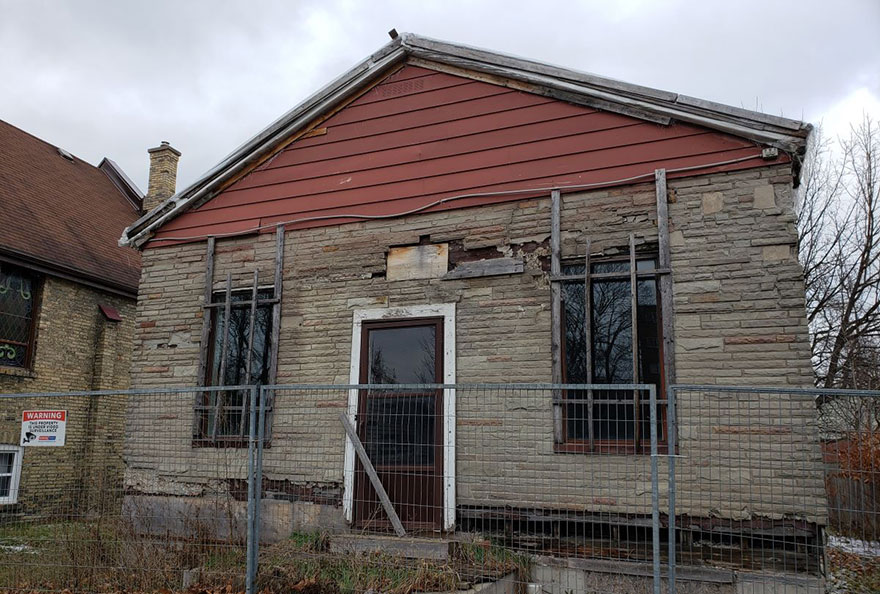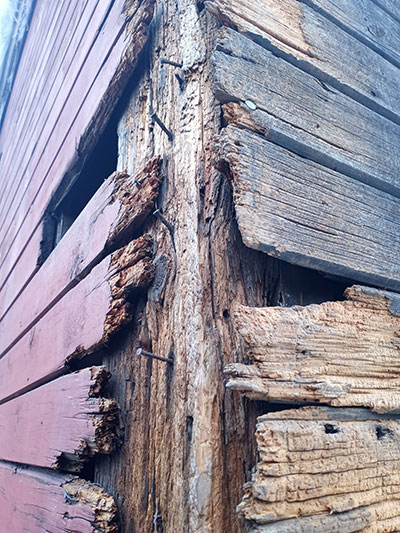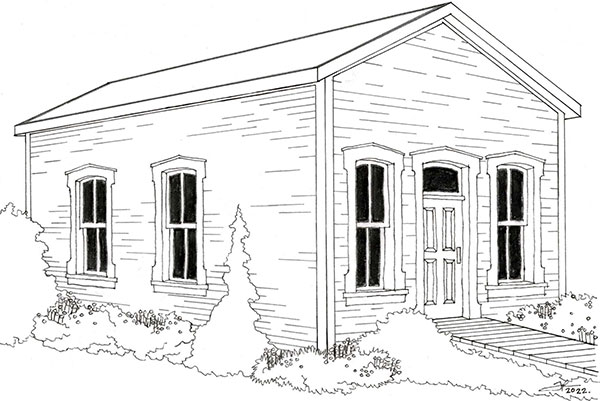News and Updates
Contact
Faculty of Social Science
Social Science Centre
Room 9438
Western University
T. 519-661-2053
F. 519-661-3868
E. social-science@uwo.ca
Western faculty take part in restoring piece of Black history
February 01, 2022
Exterior shot of the former African Methodist Episcopal Church. The building represents a significant part of London's history - photo by Dawn Miskelly
Story by Rob Rombouts
The former home of the African Methodist Episcopal Church is a small, unassuming wooden building, but it is also a connection to the earliest history of the Black community in London, Ont. Efforts are underway to save the chapel and what it represents, supported by members of the Western community.
“It is one of the only material pieces of early Black history in London; certainly, the only building,” said Thomas Peace, professor of history at Huron University College, and chair of the board of the Fanshawe Pioneer Village, where the old chapel will be relocated. “It is a symbol of a vibrant community in London, not just of people who experienced enslavement directly, but also Black people who came to London who weren’t enslaved. The chapel represented that community and connection right up to and when it was replaced.”
Constructed in 1848 by formerly enslaved people who escaped the United States, the church became a haven for them and the centre of the Black community in London. By 1869, as the community grew, a new, more permanent church was built on Grey Street. Seen as a daughter chapel to the original, the Beth Emmanuel Church, became the new centre of the Black community – and the original chapel was turned into a private residence home and began fading into history.
In 2014, the chapel was moved from its original location on Thames Street, to sit beside Beth Emmanuel. Now, discussions are underway to move and restore the old chapel – now referred to as the Fugitive Slave Chapel – incorporating it into the Fanshawe Pioneer Village.
Michelle Hamilton, professor in Western’s public history program, and a member of the Planning Committee of Fanshawe Pioneer Village, said the building is an important part of London’s history. “It’s one of the oldest buildings in London, and an example of a building built by ordinary people. It’s important architecturally and for community history.”
Nuanced history
 The chapel connects to a wider history on Canada and the United States.
The chapel connects to a wider history on Canada and the United States.
“By the late 1840s there were an estimated 300 to 400 people in London's Black community, and the community continued to grow after the passage of the U.S. Fugitive Slave Law of 1850, which made life in the United States more difficult and more dangerous for free people of colour, as well as for people fleeing from enslavement,” said Nina Reid-Maroney, professor of history at Huron University College.
Hamilton said the former African Methodist Episcopal Church is among several chapels built by formerly enslaved people who came to Ontario, and it is one of the last surviving. Unverified stories say it is where American abolitionist John Brown came to rally free Black people to support his cause in the 1850s. In 1859, Brown led a raid on Harpers Ferry in Virginia, to initiate a slave revolt.
“A lot of people would say it represents London’s welcoming attitude to Black people as early as 1840s,” said Hamilton. “It’s a more nuanced story and not everyone was welcoming.”
Hamilton said the original site of the chapel was in a flood plain, and “was a de facto segregated neighbourhood.”
During the Civil War, London was also host to Confederate soldiers, who lived in hotels in the downtown area.
Peace points to the story of London-born Richard Berry Harrison, a renowned Broadway actor in the 1930s, who would have been connected to the community centred around the chapel. His parents were among the slaves who escaped through the Underground Railroad. During an upsurge in racism in London, Harrison, then 18 years old, and his family moved to Windsor, Ont., and then to Detroit where there was a more vibrant and welcoming Black community. Their home in London was destroyed by an arsonist soon after they left.
“Many African-Canadians in London and elsewhere returned to the United States to help with the war effort, and to help with Reconstruction in the post-war period,” said Reid-Maroney. “The end of American slavery in 1865 slowed Black migration to Canada, but London's Black community remained vibrant.”
For Hamilton, the old chapel represents the need for more research to develop a more nuanced view of what London, and Canada, was like. It is also an opportunity for Black and white Londoners interested in heritage to work collaboratively.
Changing the narrative

Concept sketch of the restorted African Methodist Episcopal Church
When the chapel was moved in 2014, discussions around its future ensued. There were suggestions to turn it into a museum focused on slavery, or on the centrality of religion to the Black experience. Others in the community wanted to use it as an extension of Beth Emmanuel’s service for the homeless community.
“Due to changing circumstances in the seven years since it was moved, (Beth Emmanuel) offered the chapel to Fanshawe Pioneer Village,” said Peace.
Incorporating the chapel into the Fanshawe Pioneer Village will provide important context that is currently missing, said Peace.
“There’s a lot more going on in London and Middlesex than what we have tended to recognize; there is a rich and diverse history in this place,” said Peace. “Pioneer has connotations of whiteness and Protestantism. The buildings on site can reinforce that narrative of whiteness and adding this building to the museum is important in changing this narrative.”
Moving and restoring the building will come at a cost, and efforts are underway to raise $300,000. The fundraising project, The Time Is Now, recently launched through the London Community Foundation.
“Having this building offered to us is really important, as it allows us to accept the building in a way that can hopefully build relationships with the wider community,” said Peace.
“African-Canadian scholars, including historian Dr. Afua Cooper, have long noted the way in which the history of Black presence in Canada has been ‘bulldozed’ from national memory,” said Reid-Maroney. “Preserving the physical structure of the Fugitive Slave Chapel can help to counter the erasure of the Black past in Canada, and enriches our sense of the complexity and richness of London’s history.”

